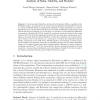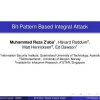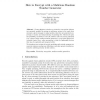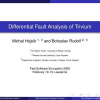ICISC
2008
14 years 29 days ago
2008
Oblivious transfer is one of the most important cryptographic primitives, both for theoretical and practical reasons and several protocols were proposed during the years. We provid...
ICISC
2008
14 years 29 days ago
2008
This paper proposes a novel technique, called instruction set limitation, to strengthen the resilience of software diversification against collusion attacks. Such attacks require a...
ICISC
2008
2008
A New Technique for Multidimensional Linear Cryptanalysis with Applications on Reduced Round Serpent
14 years 29 days ago
Abstract. In this paper, we present a new technique for Matsui's algorithm 2 using multidimensional linear approximation. We show that the data complexity of the attack can be...
FSE
2008
Springer
14 years 1 months ago
2008
Springer
The stream cipher Salsa20 was introduced by Bernstein in 2005 as a candidate in the eSTREAM project, accompanied by the reduced versions Salsa20/8 and Salsa20/12. ChaCha is a varia...
FSE
2008
Springer
14 years 1 months ago
2008
Springer
FSE
2008
Springer
14 years 1 months ago
2008
Springer
MD4 is a hash function introduced by Rivest in 1990. It is still used in some contexts, and the most commonly used hash function (MD5, SHA-1, SHA-2) are based on the design princip...
FSE
2008
Springer
14 years 1 months ago
2008
Springer
Chosen-plaintext attacks on private-key encryption schemes are currently modeled by giving an adversary access to an oracle that encrypts a given message m using random coins that ...
FSE
2008
Springer
14 years 1 months ago
2008
Springer
FSE
2008
Springer
14 years 1 months ago
2008
Springer
Abstract. A corrector is used to reduce or eliminate statistical weakness of a physical random number generator. A description of linear corrector generalizing post-processing desc...
FSE
2008
Springer
14 years 1 months ago
2008
Springer
Abstract. In this paper we present an efficient algorithm for the retrieval of the RC4 secret key, given an internal state. This algorithm is several orders of magnitude faster tha...





